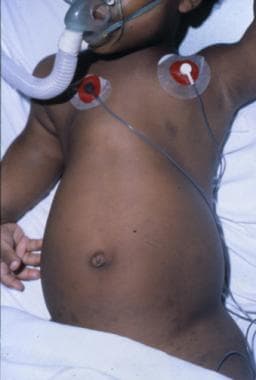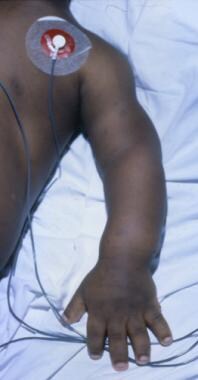Practice Essentials
Asphyxiating thoracic dystrophy, or Jeune syndrome (JS), is a rare autosomal recessive ciliopathy characterized by multiple skeleto-muscular abnormalities, multi-organ involvement, and variable severity.
A very narrow thorax with shortened ribs and variable limb shortening are hallmarks of JS. Other associated anomalies include brachydactyly and polydactyly as well as renal dysfunction (typically in later life), hepatic dysfunction, and retinal dystrophy. Mutation in the DYNC2H1 gene is the most commonly described defect.
Children with JS often present in the neonatal period with respiratory distress and recurrent infections, although it has been found that in patients with the disease who survive long-term, respiratory problems tend to decrease with age.
Workup
Laboratory studies recommended in JS include urinalysis (for hematuria, proteinuria, defective urine concentrating capacity) and arterial blood gas (ABG) sampling (since hypoxia and hypercarbia in room air reflect severe restrictive lung disease).
Newborn and infant radiography may reveal the following:
-
Small and bell-shaped thorax with reduced transverse and anterior-posterior diameter
-
Short and horizontally oriented ribs with irregular costochondral junctions and bulbous and irregular anterior ends
-
Short, squared iliac wings
-
Trident appearance of acetabular margin
-
Short limbs relative to trunk
-
Variable limb shortening
-
Short phalanges, metacarpals, or metatarsals, with or without polydactyly
-
Premature ossification of the capital femoral epiphyses
Childhood radiology may reveal the following:
-
Relatively large thorax with growth of ribs
-
Short ilium with normal flaring of iliac wings
-
Striking cone-shaped epiphyses and early fusion between the epiphyses and metaphyses of the distal and middle phalanges
-
Short distal and middle phalanges
-
Varying shortening of extremities relative to trunk
Prenatal ultrasonography may reveal the following:
-
Detection of affected second-trimester and third-trimester fetuses of at-risk families has been reported
-
Characteristic findings include a narrow thorax, short hypoplastic ribs, and short tubular bones
-
Other ultrasonographic findings include polyhydramnios and absent or feeble fetal respiratory movements
Pulmonary function testing may reveal severe restrictive lung disease. Renal biopsy may reveal cystic tubular dysplasia with or without glomerular sclerosis.
Management
The priority in managing patients with JS is supporting respiratory function. Mechanical ventilation is urgently required in the most severe cases, in which respiratory distress develops immediately after birth. Less severe cases gradually progress to respiratory failure as a result of multiple recurrent pulmonary infections.
Surgery is indicated only in the most severe cases, in which failure to intervene will result in progressive pulmonary damage and eventual death. Chest reconstruction and enlargement of the thoracic cage by sternotomy and fixation with bone grafts or a methylmethacrylate prosthesis plate provides patients with the time needed for thoracic cage growth.
A procedure of lateral thoracic expansion has been described in JS. The chest wall is enlarged by dividing the ribs and underlying tissue in a staggered fashion so that either rib or periosteum covers the lung. This procedure has been found to be safe and effective in selected patients older than 1 year.
A vertical, expandable prosthetic titanium rib is a safe tool for the treatment of children with thoracic insufficiency syndrome. It may decrease carbon dioxide retention in some patients and may be most beneficial in younger children.
Background
In 1955, Jeune et al described familial asphyxiating thoracic dystrophy in a pair of siblings with severely narrow thoraxes.
This condition is also known as Jeune syndrome, a rare autosomal recessive disorder characterized by typical skeletal dysplasias, such as a narrow thorax and micromelia, with respiratory and renal manifestations. [1, 2] Respiratory symptoms widely vary from respiratory failure and infantile death to latent phenotype without respiratory symptoms. See the images below.
Pathophysiology
JS has a wide variability of expression due to genetic heterogeneity. All patients have small chests, but the degree of the respiratory distress varies from negligible to rapidly fatal. In the more severe forms, patients present at birth with a narrow, immobile chest; short ribs and limbs; and characteristic radiographic changes. Lung hypoplasia, due to a restricted thoracic cage, is the major cause of death in infancy. Patients who survive the newborn period may later develop renal and pancreatic insufficiency. [3]
Epidemiology
Frequency
United States
Incidence is estimated at 1 case per 100,000-130,000 live births. [4]
Mortality/Morbidity
Although JS may be associated with bilateral microcystic renal disease, which may gradually progress to tubular atrophy and renal failure, the most common and prominent clinical presentation is respiratory failure secondary to restrictive lung disease as a result of short horizontally placed ribs.
Furthermore, most patients with JS (approximately 60-70%) die from respiratory failure in early infancy or early childhood. Chronic renal failure may ensue in survivors.
Few patients reach adolescence or adulthood.
Race
JS has no race predilection.
Sex
The syndrome is not associated with any sex predilection.
Age
JS may be detected at birth or during infancy because of typical clinical and radiographic signs.
Prognosis
The prognosis in JS depends on its expression.
Patient Education
Helpful links
These include the following:
US National Library of Medicine: https://ghr.nlm.nih.gov/condition/asphyxiating-thoracic-dystrophy
Genetic and Rare Diseases Information Center: https://rarediseases.info.nih.gov/diseases/3049/jeune-syndrome
Jeune Syndrome Foundation: http://www.jeunes.org.uk/
-
An infant with Jeune syndrome. Note the narrow chest and shortened upper extremities.
-
A child with Jeune syndrome. Note long narrow thorax with respiratory difficulty.
-
Note cystic renal dysplasia on the left kidney and renal hypoplasia on the right kidney.
-
Note the narrow chest and shortened ribs.
-
Note the shortened upper extremity with acromelic shortening.













